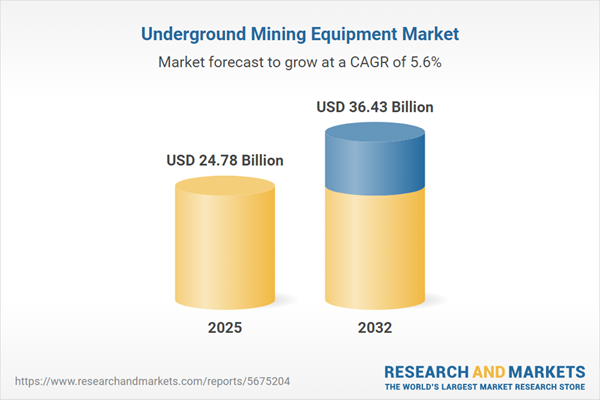Speak directly to the analyst to clarify any post sales queries you may have.
Senior leaders in the underground mining sector face complex procurement, technology, and supply chain challenges requiring robust market intelligence. This report discloses actionable insights to guide executive strategies and strengthen operational performance in a shifting regulatory and market landscape.
Market Snapshot: Underground Mining Equipment Market Size, Trends, and Outlook
The underground mining equipment market is experiencing consistent growth as enterprises expand mineral extraction and accelerate digital transformation. Current market valuation stands at USD 23.47 billion, with projections indicating USD 24.78 billion by 2025 and USD 36.43 billion by 2032, yielding a compound annual growth rate of 5.64%. Industry players are prioritizing digital solutions to reinforce risk management and improve safety in daily operations. Evolving technologies help companies strengthen compliance, adapt effectively, and streamline outputs across diverse mining settings. As advanced solutions become central to operations, organizations are realigning investments to sustain competitiveness and regulatory alignment.
Scope & Segmentation: Underground Mining Equipment Market
This report addresses the core procurement and operational questions of senior executives responsible for underground mining projects. By clarifying the intersection between regional regulations and technology adoption, it empowers informed decisions on equipment, resource allocation, and supplier development in an evolving global market.
- Equipment Type: Digitalized drilling rigs, automated loaders and haulers, sophisticated ventilation systems, and roof supports embedded with sensors and telematics, each delivering real-time monitoring and predictive maintenance.
- End Use: Solutions tailored for coal, industrial mineral, and metal ore operations, incorporating advanced telemetry and digital platforms to support efficiency in remote and challenging sites.
- Propulsion Technology: Diesel, battery-electric, electric, and hybrid units offer multiple emissions profiles, supporting organizational sustainability targets aligned with global and local mandates.
- Installation: Providers deliver seamless implementation and upgrades, enabling alignment with industry safety standards, modernization goals, and shifting compliance frameworks.
- Distribution Channel: Options spanning direct manufacturer arrangements, distributor partnerships, and digital marketplaces bolster supply chain resilience and keep equipment resources flexible and responsive.
- Region: The Americas, Europe, Middle East & Africa, and Asia-Pacific reflect differing strategies and adoption rates influenced by resource profiles, regulations, and technology integration trends.
- Key Players: Leading entities—Caterpillar Inc., Komatsu Ltd., Sandvik AB, and Epiroc AB—drive industry best practices and underpin ongoing global advancements in safety and operational efficiency.
Key Takeaways for Senior Decision-Makers
- Digital transformation allows consistent regulatory compliance and streamlines procedures, resulting in more uniform workflows and reliable site operations.
- Transitioning to low-emission or electric-powered machinery supports environmental strategies and prepares operations for increasingly stringent emissions policies.
- Strengthening supply networks through multiple procurement channels and resilient supplier relationships lessens exposure to disruptions and stabilizes sourcing amidst volatility.
- Implementing advanced ventilation and reinforced structural systems directly addresses unique underground health and safety concerns.
- Upgrading fleets with hybrid and digital-enabled solutions ensures modernization with cost control and compliance adaptability.
- Embracing digital procurement enhances process oversight, improves transparency, and elevates agility as regulations and business needs change.
Tariff Impact: Navigating Cost Structure and Sourcing Choices
Recent tariff changes in the United States have spurred mining operators and equipment providers to adjust sourcing and manufacturing strategies. Locating production closer to demand hubs is proving effective for supply stabilization and cost management. Ongoing tariff assessments position procurement teams to proactively address risks arising from regulatory shifts, incentivizing strategic realignment of logistics and supplier portfolios.
Methodology & Data Sources
The findings are informed by structured interviews with senior mining executives, operational leaders, and top equipment providers. Secondary research and consultations with industry specialists validate the relevance of insights and ensure alignment with sector priorities and practical challenges.
Why This Report Matters for B2B Leaders
- Delivers actionable underground mining equipment market intelligence for refining procurement timelines, operational tactics, and alignment with organizational priorities.
- Enables proactive adaptation to emerging regulatory landscapes through region-specific insights and supports tailored procurement in complex jurisdictional contexts.
- Provides practical recommendations for deploying automation and digital systems to sustain performance and competitive advantage in evolving mining environments.
Conclusion
By leveraging comprehensive intelligence and adaptable strategies, mining industry executives can fortify operational resilience and encourage sustainable sector growth in a dynamic market.
Additional Product Information:
- Purchase of this report includes 1 year online access with quarterly updates.
- This report can be updated on request. Please contact our Customer Experience team using the Ask a Question widget on our website.
Table of Contents
3. Executive Summary
4. Market Overview
7. Cumulative Impact of Artificial Intelligence 2025
Companies Mentioned
The companies profiled in this Underground Mining Equipment market report include:- Caterpillar Inc.
- Komatsu Ltd.
- Sandvik AB
- Epiroc AB
- Atlas Copco AB
- Metso Outotec Corporation
- FLSmidth & Co. A/S
- Liebherr-International Deutschland GmbH
- ABB Ltd
- Boart Longyear Limited
Table Information
| Report Attribute | Details |
|---|---|
| No. of Pages | 193 |
| Published | November 2025 |
| Forecast Period | 2025 - 2032 |
| Estimated Market Value ( USD | $ 24.78 Billion |
| Forecasted Market Value ( USD | $ 36.43 Billion |
| Compound Annual Growth Rate | 5.6% |
| Regions Covered | Global |
| No. of Companies Mentioned | 11 |









